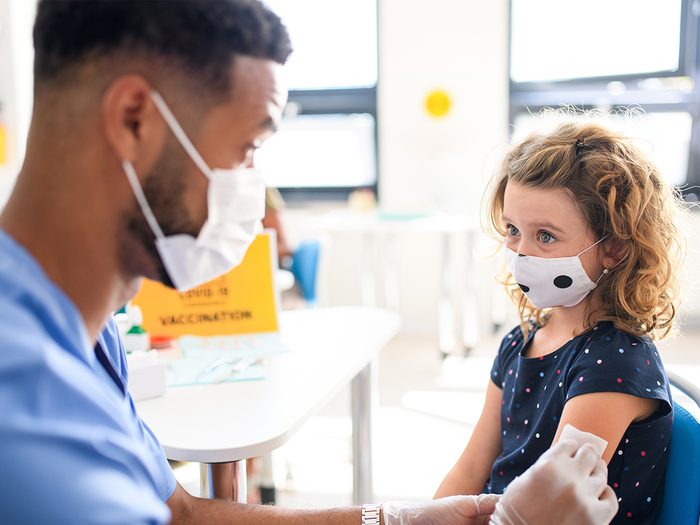Expert Explainer: What You Need to Know About COVID Vaccines for Kids 5-11

Internal medicine physician Dr. Seema Marwaha clears up some of the frequently asked questions and concerns about COVID vaccines for kids.
While many parents promptly booked the Pfizer-BioNTech COVID-19 vaccinations for children aged 5 to 11 after Health Canada’s authorization Nov. 19, others have questions they need answered before they feel comfortable.
As a parent myself, I understand how important it is to keep our children safe from even the slightest of harms. I’ve had many patients ask me if the vaccine is necessary and if it’s safe. I always reassure them that it is safe, effective and that the benefits far outweigh the risks—especially heading into winter. But more specific questions usually follow. I try to answer the most heard questions here.
Is the vaccine safe?
Yes. We are fortunate in Canada to have both Health Canada and the National Advisory Council on Immunization (NACI) closely follow the evidence. They did this with adult and adolescent vaccines and are continuing the process with children. Not only do they monitor the trial data, they also look at real world data as well. For pediatric vaccines, both bodies have reviewed all available data, had the opportunity to go back to Pfizer with questions and have also been monitoring what is happening with the pediatric vaccine campaign in the U.S., where as of last week almost three million children had received their first doses since the Food and Drug Administration’s authorization in late October. We should be confident in this process and know that the benefits of the vaccine outweigh any potential risks.
Is it effective?
Yes. The Pfizer trial looked at about 4,700 children who got the vaccine versus a placebo, their immune response, their antibody levels and how well it worked to ward off the virus. It was found to be 90 percent effective in preventing symptomatic COVID compared to a placebo. This includes the Delta variant.
What are the benefits?
While it is true that children are less likely to get severely ill than adults, it can happen and it’s tragic when it does. It is very difficult to predict who will get critically sick and who will not. In children aged 5 to 11 in the U.S., there have been more than 146 COVID related deaths and almost 8,300 children have been hospitalized. Many of these children were completely healthy with no pre-existing conditions. In Canada, we haven’t seen this degree of pediatric illness, but as we loosen restrictions, children will be at higher risk as they are unvaccinated. As a parent, if you can protect your children from any risk, you do it.
Not only is severe illness prevented, the vaccine also can reduce transmission to other groups. You might not have to worry as much about going to school, seeing friends or disruptions in routine. However, this depends on your family unit. If there are older adults or people who are immunocompromised, you need to be mindful of your and your children’s activities and the risk to others.
Vaccinating your child may not be a bulletproof vest. But there is a significant reduction in getting and spreading COVID. And each person in the community that gets vaccinated gets us one step closer to ending the pandemic.
If children have only one vaccine dose, are they still protected enough to see loved ones?
So far, we do not have a breakdown of the difference between doses. In the 21-day waiting period between doses in the trial, there were no infections so it’s hard to know the exact level of protection at that point. Two weeks after the first dose, children have some protection, but we don’t know how much yet. Again, we need to look at the local situation: who you live with; what their situations are; and what steps you are taking to determine the risk. Ideally, if everyone you are visiting is healthy and vaccinated and you are being careful—avoiding crowded areas, getting tested, avoiding contact if symptomatic—together with one dose of a vaccine, this can significantly reduce risk for all involved, including children. Rapid testing might be useful before gatherings. But the vaccine is the quarterback here and makes all the other public health measures work better.
Can you get a flu shot and COVID shot before the holiday?
In children aged 5 to 11, Health Canada recommends the COVID vaccine be separated from other vaccinations by 14 days. This is out of an over-abundance of caution to see if there are possible side effects to the COVID vaccine specifically. However, the U.S. Centres for Disease Control has not made this recommendation for young children. And for all people 12 and up, you can get it at the same time or separately. Because there is more COVID circulating than influenza, I would recommend children under 11 get the COVID vaccine first and then get the flu vaccine.
(Related: Flu Season Is Going to Hit Hard. Here’s How to Prepare)
Is it true that Pfizer added a heart attack medicine as an ingredient to the children’s dose of the vaccine? If so, why is this?
There is a very small amount of tromethamine in the vaccine for children. But it is not to treat heart attacks. Rather, it is used to regulate acidity in body fluids in cases of metabolic acidosis, which can be the result of various conditions, including bypass cardiac surgery and cardiac arrest. It’s also a common stabilizing ingredient in a lot of medical and non-medical products. It helps the vaccine resist degradation and improve its shelf life. It’s also not new or experimental. Tromethamine has been safely used in many products, including the Moderna COVID-19 vaccine, Humalog insulin and other vaccines.
All changes in formulation to the pediatric vaccine also needed to be specifically reviewed and approved by Health Canada.
Keeping in mind that the U.S. has used shorter intervals than Canada (for adults AND children), what is an acceptable interval between shots one and two for children?
Health Canada has approved the doses to be given 21 days apart. But NACI is recommending eight weeks between doses because longer intervals could make the vaccine slightly more effective with lower side effects. The specific dosing interval used will be up to the individual provinces.
What are the side effects? What should we expect?
The most common was a sore arm that resolved in 24 to 48 hours. Headache, fever and muscle aches were also common and all passed within 24 to 48 hours. The lower side-effect profile is partly because of the way children’s immune systems develop and partly because of the lower dose they get.
You might want to take it easy the next day if you are worried about side effects, but most kids won’t need to miss school.
What about cardiac side effects like myocarditis?
We expect that the rates of myocarditis and pericarditis will be very low. The aged 12 to 15 group was at lower risk than the 16 to 24 group so we expect it to be lower still for the 5 to 11 group. Those aged 5 to 11 generally have a lower baseline risk of myocarditis from other viruses. And they are getting a lower dose of vaccine.
It’s also much less severe than COVID-related myocarditis which makes you quite sick with possible long term health effects.
We also have the luxury of the U.S. being a few steps ahead since it has administered millions of doses to those aged 5 to 11. The U.S. is also giving second doses at three-week intervals. So, we will know much more based on American data as many children will have two doses there before our children get one.
What are the symptoms of myocarditis?
If your child has chest pain, difficulty breathing, lethargy or fever that does not break—seek medical attention. A non-invasive ultrasound test will be done if myocarditis is suspected though it would be exceedingly rare. Parent instincts are also very strong. If a child seems lethargic or ill, have the child checked even if just for reassurance.
What about long-term side effects?
We do not expect any long-term side effects. To understand why, it’s important to understand how the vaccine works. In the first few days, there is an immediate response to the vaccine in your system and local effects from the injection. This is why you get a sore arm, fever, malaise, etc. In the second phase, you get your immune response that peaks over weeks. Your body no longer increases the immune response to the vaccine after four-to-six weeks. This why we would see all serious side effects within six weeks. The vaccines are limited in what they do and disappear from the body quickly. They can’t change how your body responds to other things.
Were these developed fast?
mRNA technology is not new. We’ve been studying it since the 1960s and doing vaccine trials since 2013. We do have some long-term data on safety of other mRNA vaccines. Some vaccines for COVID (other than AstraZeneca and Johnson and Johnson) were built on this research, which is in part why we could develop them so quickly.
Why would my almost 10-year-old get one third of the dose a 12-year-old gets when they are basically the same size? Does this smaller dose provide enough protection?
Children get 10 mcg (micrograms), or one-third of the dose for 12 and up. The trial looked at 10/20/30 mcg doses and with 10 mcg, there was the same effect with less side effects. Vaccine dosing is not based on weight or size of child, but maturity of the immune system. The study examined immunogenicity for all age groups. In the 5 to 6, 7 to 8, 9 to 11 ages and in aggregate, all had a similar and robust immune response.
If your child is on a cusp year, what should you do?
This might differ province to province. Anyone turning 5 years old in 2021 in Ontario is eligible to get the vaccine now. What we don’t know is what to do with children turning 5 in 2022. Trials studying children 4 and under with different doses are ongoing so I suspect we may have to wait for the trial results.
On the older spectrum, don’t wait for the adult and over 12 dose. Get the dose available as soon as possible if your child is of the age to get it. The study included 11- and almost 12-year-olds and that cohort had a good immune response. When they turn 12, they can get the adult dose as their second shot. Going into the holidays, with COVID rates increasing, get them the dose.
Can you apply a numbing cream pre shot?
Yes, we do it with other vaccines. Some places have it on hand. This is a great idea if a child is afraid of needles.
My child has anaphylactic allergies to other things. Should I worry?
There is no increased risk of reaction if you have other allergies, including eggs, penicillin, peanuts, etc. We’ve seen very little severe allergic reactions with this vaccine. In the trial of almost 4,700 children, there were zero severe allergic reactions. In the U.S., there have been no severe allergic reaction reports since children have been eligible.
There are no pre-existing health conditions that put a child at a higher risk either. They would actually be at higher risk from COVID complications, so the benefit-to-risk ratio is even greater for this age group.
How long can the vaccine stay in our body?
Vaccines are rapidly broken down and removed from the body. mRNA vaccine contains a fatty shell surrounding mRNA particles. Once it enters the cell, the lipids get broken down, the mRNA is used to make spike proteins and then it also is broken down. Once it’s done its job of getting cells to produce spike proteins, our immune system starts making antibodies to it. If our immune cells ever see this protein again in the form of a viral infection, it will be able to recognize and fight it much faster. It does not cause an alteration in our DNA. The spike proteins are immediately recognized as foreign and destroyed—this is how our immune system “army” trains to kill the real virus. Antibodies to spike proteins stick around for months and eventually are replaced by memory immunity.
How will vaccinating children affect the pandemic?
As an individual, take a deep breath to know your child is safer as the risk of serious health outcomes is low. In terms of the world, it will further decrease the cases. If we reach a high level of vaccine uptake, there won’t be a large reservoir for transmission. We won’t see explosive outbreaks and it will lower the risk of activities. We don’t have a crystal ball but hopefully it will make life a little easier.
If you have more questions, where do you go?
Go to trusted sources.
Social media, blogs, Google could lead you to sites that are deliberately spreading disinformation. So stick to sources that you can trust, such as ScienceUpFirst. Refer to hospital hotlines like SickKids, TEGH. Reach out to your primary care doctor, get the answers you need and then share the information.
This story originally appeared on Healthy Debate.
Next: Everything You Need to Know About COVID Antiviral Pills




